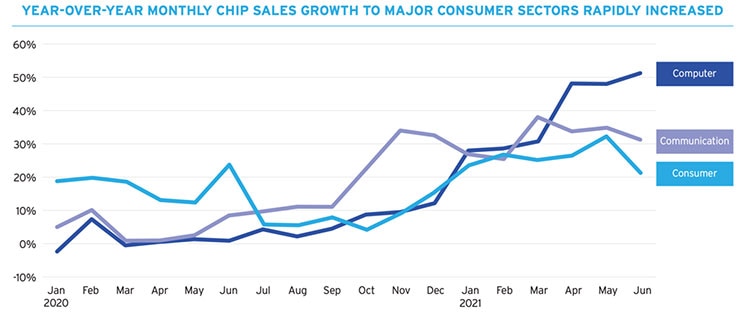Tech Community Gets Behind CHIPS Act in the Hope of a More Balanced Supply Chain
In recent years, the United States has been more known for its consumption of semiconductor technology than its capabilities in making these critical microelectronic products. The CHIPS for America Act of 2022[1], though, promises to push domestic innovation in terms of semiconductor manufacturing, design, and research.
President Biden signed the act into law early last month. The legislation allocates $54.2 billion in funding to support U.S. domestic technology innovation, primarily aimed at the semiconductor industry. This legislation is part of a larger $280 billion CHIPS and Science Act[2] appropriation.
 Figure 1: The CHIPS Act of 2022 aims nearly three-quarters of its funding, about $39 billion, toward semiconductor incentives and another $11 billion toward R&D. (Image source: Forrester)
Figure 1: The CHIPS Act of 2022 aims nearly three-quarters of its funding, about $39 billion, toward semiconductor incentives and another $11 billion toward R&D. (Image source: Forrester)
U.S. loses its footing
Sixty years ago, the semiconductor chip was invented in the U.S., and over the ensuing years, it assumed a leadership position in technology manufacturing. Now, however, about one-tenth of the world’s supply of semiconductors is produced in the U.S.—and yet it buys about half of the total chips sold. In 1990, that figure was considerably higher—with the U.S. making about 37 percent of chips. Those figures don’t paint a picture of success.
Meanwhile, three-quarters of the world’s semiconductor manufacturing is done in East Asia. The widening gap can be traced to the Chinese government subsidizing chip manufacturing to the tune of $100 billion. By comparison, federal investments by the U.S. have remained flat, relative to gross domestic product (GDP). This considerable investment by other countries in their domestic semiconductor industries has allowed these regions to advance rapidly in their technology capabilities.
The high cost of building a semiconductor fab in the U.S. makes it more challenging to stay at the forefront. Over a decade, building and operating a fab in the U.S. costs about 30 percent more than it does in Taiwan, South Korea, or Singapore, and as much as 37 to 50 percent more than putting one in China, according to the Semiconductor Industry Association (SIA). That differential and cost can be traced directly to government incentives.[3]
Semiconductors as a critical resource
The importance of semiconductors to the U.S. economy should not be understated. These chips enable key technologies, such as artificial intelligence (AI), 5G/6G, quantum computing, and cloud services, all of which contribute to the U.S. economy as well as its national security.
Further, recent months have underlined how semiconductor shortages can slow that economy and frustrate consumers.
 Figure 2: Semiconductor sales are growing in a variety of industries and will continue to grow over time. (Image source: SIA)
Figure 2: Semiconductor sales are growing in a variety of industries and will continue to grow over time. (Image source: SIA)
The average consumer is now familiar with the concept of “supply chain problems” that have kept everything from electric cars and appliances out of reach by slowing down delivery. With so many products containing electronic components, manufacturers across every sector, from aerospace, defense, and medical, to automobiles, communications, information technology, and manufacturing, will need an increasing number of chips. To meet this need, something has to give, and that “give” has come in the form of governmental support.
What’s in the CHIPS Act?
The CHIPS Act focuses on research and development and domestic manufacturing of semiconductors. “The innovation ecosystem that leads advanced research and development into semiconductors and microelectronics will soon receive an injection of new energy—$13 billion in targeted federal funding for everything from prototyping and commercialization to manufacturing,” said Dr. Alondra Nelson, the Director of the White House Office of Science and Technology Policy (OSTP).[4] It aims to create domestic semiconductor fabs onshore in the U.S. The high cost of domestic manufacturing is what has historically pushed OEMs to offshore the manufacturing of products, but with this type of support, innovation created here can also be made here.
A relatively small amount ($2 billion) is earmarked to existing or legacy chips used by automotive and defense manufacturers, with the lion’s share setting its focus on innovation. About $13.2 billion is earmarked for developing the semiconductor workforce—which is critical both to the success of the industry and to the economic success of the U.S.
The CHIPS Act has the potential to add jobs for skilled workers in the U.S. and to address some of the supply chain uncertainty in the global market that can be traced to the complexities of offshore manufacturing, ranging from shifting tariffs and unexpected overseas natural disasters. To take full advantage of it, semiconductor OEMs will have to rethink their global strategies. Still, this isn’t going to be a quick fix—fabs take years to build—but it’s a promising start toward a more balanced supply chain.
References:
1: https://www.commerce.senate.gov/services/files/592E23A5-B56F-48AE-B4C1-493822686BCB
2: https://science.house.gov/chipsandscienceact
3: https://www.semiconductors.org/turning-the-tide-for-semiconductor-manufacturing-in-the-u-s/

Have questions or comments? Continue the conversation on TechForum, DigiKey's online community and technical resource.
Visit TechForum









